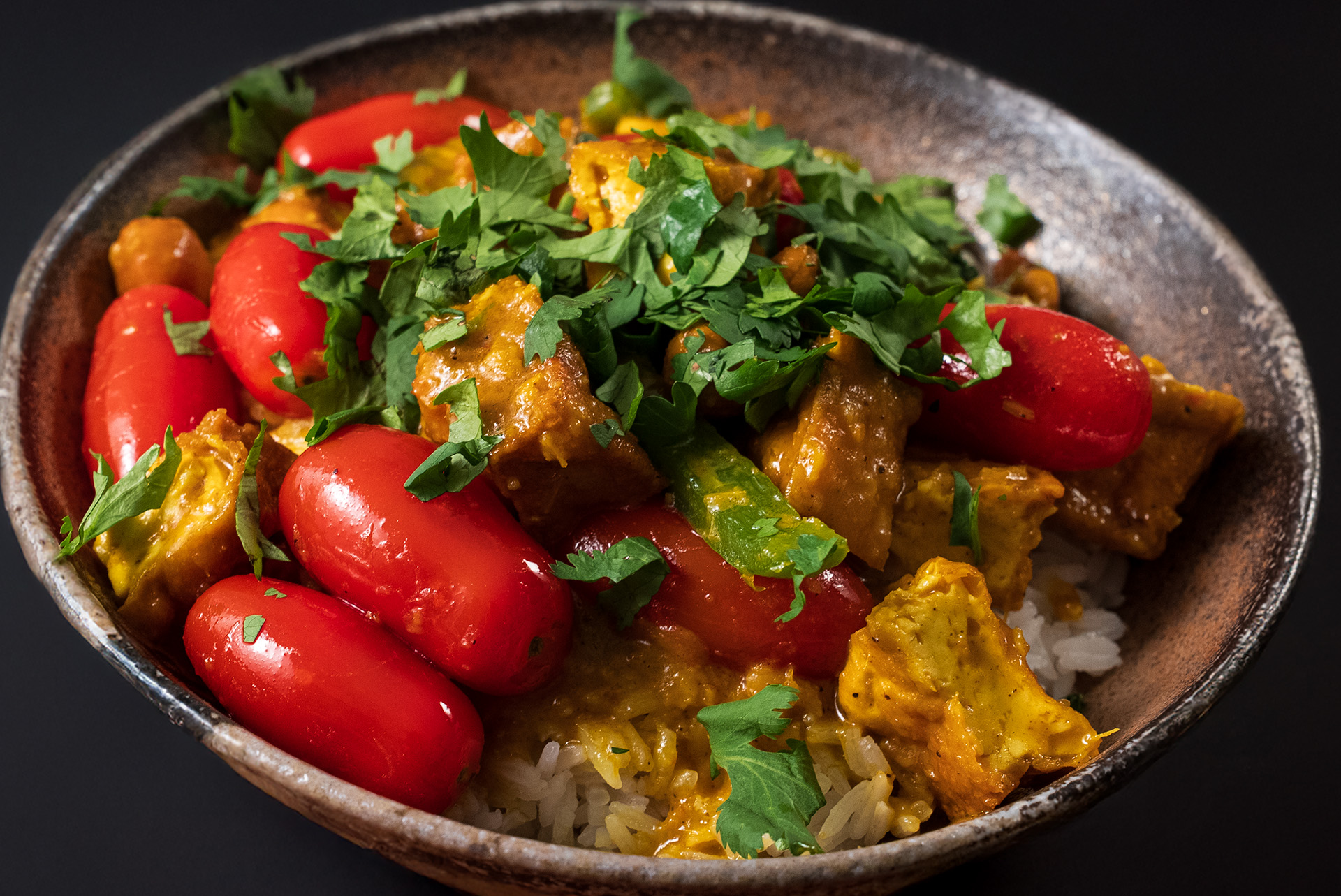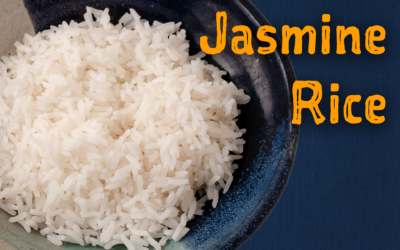A bright, fresh, golden coconut curry built on a deeply aromatic paste of mortar and pestle ground lemongrass, chilis, garlic, shallot, black pepper, coriander seeds, and turmeric. Balanced with the sweet, rich creaminess of coconut milk, palm sugar, and peanuts, this dish has a complex flavor profile that hits every note on your palate. Paired with fried tofu, cherry tomatoes, cashews, and green bell pepper over a bed of steamed jasmine rice and finished with fresh cilantro, this aromatic lemongrass and turmeric curry will leave you addicted.
Lemongrass Turmeric Curry Ingredients
(In order of usage)
Coriander Seeds
Coriander seeds have a warm, piney, and citrusy flavor that plays well with the other aromatics, especially lemongrass. Toasting whole coriander seeds in a dry pan before grinding helps release their essential oils and volatile compounds: linalool (citrusy), pinene (piney), and geranyl acetate (floral). Toasting also creates new earthy, nutty, and smoky flavors through the Maillard reaction. This flavor profile beautifully ties together the lemongrass, black pepper, and turmeric in this dish.
Black Peppercorns
Freshly ground whole black peppercorns have a rich palette of peppery, spicy flavor with subtle citrus and floral notes. Dry toasting them, like the coriander seeds, helps release their volatile organic compounds: piperine (hot and peppery), pinene (piney), linalool (citrusy), terpenoids (floral), and esters (fruity and floral). This signature flavor profile plays well with the heat of the chilis, the citrusy notes of the lemongrass and coriander, and the floral notes of the turmeric.
Lemongrass
Lemongrass is the star in this curry, helping keep it light, bright, and fresh even with its rich, creamy base. Lemongrass has a powerful citrus profile with subtle floral and herbal notes from its VOCs: citral (lemony), myrcene (herbal and floral), linalool (citrusy), and limonene (lemony and citrusy). The fresh flavor of lemongrass ties perfectly into the coriander, turmeric, and black pepper.
Lemongrass stalks can be easily sourced at most Asian grocery stores.
Salt
Salt does more than just season the curry — it’s an essential tool in the paste itself. A pinch in the mortar acts like an abrasive, helping break down the fibrous aromatics and drawing out their natural oils as you pound. It sharpens the bright notes, balances bitterness, and pulls all the flavors forward so every bite hits deeper.
Roasted Peanuts
Roasted peanuts add a subtle nutty richness to the paste, giving it smooth body and extra depth that pairs beautifully with the creaminess of the coconut milk. Their natural oils help bind the aromatics as you pound, and the mild creaminess balances the heat and spice. A small handful is enough to make the paste feel richer and the final curry taste extra lush.
Red Birds Eye Chili
Red bird’s eye chilis (sometimes called Thai chilis) are the backbone of the spiciness in this curry. Their VOCs, mainly capsaicin (hot, lingering spiciness) and esters (fruity and floral), play nicely off the black peppercorns and provide a sharp contrast to the coconut milk, palm sugar, and lemongrass.
Shallots
Shallots, part of the Allium family, share a lot of similarities with onions while having a more delicate, sweet, sulfury flavor that rounds out the sharper aromatics in the paste. Their natural sugars mellow the bite of the chilis and black pepper, helping the curry taste balanced instead of harsh. Breaking them down into the paste in a mortar and pestle fully releases their flavor by rupturing their cell walls. The shallots’ VOCs, mainly sulfur compounds like allicin, add a mild pungency and gentle garlic-like edge that ties everything together.
Fresh Garlic
Garlic, also part of the Allium family, brings a sharp, pungent backbone to the paste and deepens its savory edge. Its VOCs, mainly allicin and other sulfur compounds, wake up when you pound the cloves, adding heat that ties perfectly into the shallots and black pepper. Once bloomed in the oil, the raw bite melts into mellow sweetness that rounds out the richness of the coconut milk and palm sugar.
Palm Sugar
Palm sugar adds a gentle, earthy sweetness that softens the sharp heat of the chilis and balances the bitterness of the turmeric and black pepper. Its mild caramel notes melt perfectly into the coconut milk, giving the curry a warm, rounded depth that plain white sugar can’t match. A small knob is enough to pull all the flavors of this curry together.
Turmeric
Turmeric powder gives this curry its deep golden color and a warm, earthy backbone with subtle sweetness, gentle bitterness, and a mild floral note. It ties perfectly into the floral notes of the lemongrass, coriander, and black pepper, and complements the sweetness of the coconut milk and palm sugar. Curcumin and turmerone, its main VOCs, give the curry depth, color, and a soft floral warmth.
Cold Pressed Peanut Oil
Unrefined peanut oil does double duty in this dish. Its subtle nutty flavor and naturally higher smoke point make it perfect for frying the tofu to a crisp, golden finish. It also works beautifully as the base for the lemongrass-infused oil that blooms the curry paste. Unlike more neutral oils, unrefined peanut oil holds onto a gentle roasted aroma that matches the peanuts in the paste and the infused oil carries the bright lemongrass flavor deeper into the curry.
Bay Leaves
Bay leaves lay down a quiet herbal backbone that deepens the curry’s flavor without stealing the show. They’re the first thing added to the hot cooking oil, toasting for a minute to release their VOCs , mostly cineole (eucalyptus-like), myrcene (herbal and floral), and eugenol (warm earthyness). This quick bloom draws out their subtle flavores before the curry paste goes in. They help balance the richness of the coconut milk and palm sugar, adding depth that ties everything together. Remember to pull them out before serving.
Coconut Milk
Full-fat coconut milk gives this curry its lush, creamy body and gentle sweetness. It softens the heat from the chilis and black pepper, balances the earthy bitterness of the turmeric, and carries the bright aromatics deeper into every bite. The natural fat in coconut milk dissolves the paste’s fat-soluble VOCs, turning it into the main flavor carrier for the whole dish. Always use good, full-fat coconut milk — it makes the difference between thin and luxurious.
Green Bell Pepper
Green bell pepper brings a grassy freshness and a gentle bitterness that slips neatly between the richer and sweeter notes of the curry. Its flavor stands apart from the aromatic coconut sauce and the bright acidity of the cherry tomatoes. Cut into thin strips, it softens quickly in the coconut milk, giving the sauce an added layer of complexity that lingers quietly in the background while still keeping a touch of crispness.
Cashews
Cashews deepen the curry’s richness with a creamy, buttery quality and a mellow nuttiness. They slip in a bit more protein alongside the tofu, while adding a tender bite that contrasts the softer vegetables. In the sauce, they quietly reinforce the sense of fullness and add another layer to its complexity.
Tofu
I use a medium-firm tofu for this curry because it holds its shape while staying soft and tender. I like to deep-fry larger blocks in peanut oil until crispy, then cut them into bite-sized pieces. This gives you a perfect contrast of crispy, seared outer skin and smooth, delicate tofu, with the freshly exposed sides soaking up more of the curry. Every bite catches the sauce and brings “exceptional mouthfeel”.
Cherry Tomatoes
Cherry tomatoes add small bursts of sweetness and acidity that break up the richness of the curry. Their naturally occurring glutamates deepen the overall flavor, giving a gentle umami lift, while their freshness keeps the dish feeling light. The way their juices mingle with the rice is quietly indulgent, and together with the cilantro, they keep a bright freshness despite the richness of the curry sauce.
Thai Basil
Thai basil folds into the curry just before it’s done simmering, releasing its bright, anise-like aroma into the sauce. Its herbal sweetness and faint pepperiness cut through the richness while echoing the floral notes of the lemongrass, turmeric, and coriander. In the heat, the leaves soften and mingle with the sauce, adding a fresh lift that carries through each bite.
Fresh Coriander / Cilantro Leaves
Cilantro finishes the dish with a burst of fresh, green brightness. Its crisp, citrusy lift lands right at the surface of the curry, cutting through the richness and tying together the fresher elements like cherry tomatoes and green bell pepper. Scattered over the top just before serving, it leaves a clean, lingering note that keeps each bite feeling light.
Aromatic Lemongrass & Turmeric Curry with Tofu & Cherry Tomatoes
Equipment
- Mortar and Pestle Extremely important for this recipie
- Ceramic Coated Cast Iron Dutch Oven
- Chefs Knife
- Cutting Board
- Wooden Spatula
- Silicone Spatula
- Carbon Steel Wok
- Deep Frying Strainer
- Measuring Cup
- Measuring Spoon
Ingredients
- 1.2 lbs Tofu (Medium Firm)
- ½ tbsp Black Pepper
- ½ tbsp Coriander Seeds
- 3 stocks Lemongrass
- ⅖ tbsp Salt
- 10 Red Birds Eye Chili Adjust for taste and varience in heat of peppers
- ¼ cup Roasted Peanuts
- 6 Garlic Cloves
- 1 Shallots
- 1 tbsp Palm Sugar
- 1 tbsp Turmeric Powder
- 1 Green Bell Pepper
- 10 oz Cherry Tomatoes
- 3 Bay Leaves
- 1 can Coconut Milk 13.5 fluid ounces
- ⅜ cup Cold Pressed Peanut Oil
- ¾ cup Cashews
- ⅝ cup water
- 12+ Leaves Thai Basil
- ¼ cup Cilantro Leaves
Instructions
- Start jasmine rice now
- Prep your fried tofu, curry paste, and slice a green pepper.
- Preheat 1 quart of peanut oil in a large carbon steel wok.
- Cut 1.2 lbs tofu into large blocks, and allow excess water to naturally drain off.
- Once frying oil comes up to temperature, gently place the tofu into the hot oil with care not to splash hot oil.
- Allow to fry with only disturbing it minimally to ensure nothing sticks together. Once tofu is halfway fried, flip as heat tends to be uneven (hotter on bottom) in shallower pans.
- Fry till golden brown then remove using a frying strainer and drain on paper towels.
- Allow to cool. Once cool slice into smaller pieces so that you have a mix of seared tofu skin and softer inner parts exposed. The sear is for texture and the exposed inner parts grab sauce and seasoning better.
- Start by measuring out 1/2 tbsp each of black pepper corns and coriander seeds. Add those to your mortar and pestle and grind into a fine powder.
- Take 3 stocks of lemongrass, trim off the base and fibrous grassier tops. Peal back outter few layers that are tougher and dirtier to expose the inner part of the lemongrass stalks. Rinse the stocks to remove any residual soil or sand that may have worked its way to the inner layers. Slice, mince, and add the lemongrass to the mortar and pestle. Pound the lemongrass into a paste breaking up as many of the fibers as possible.
- Add 3/4 tbsp of salt to the mortar and pestle. This will be all of the salt for the dish as well as act as an aggregate to further help break down the lemongrass fibers and release it’s oils.
- Slice 10-12 birds eye chilis. Pushing the other ingredients up the sides to expose stone at the bottom, add the birds eye chilis to the mortar and pestle. Pound with the pestle until the chilis break down into a paste and then reincorporate the other ingredients.
- Add 1/4 cup of dry roasted peanuts and pound them into the paste until fully incorporated.
- Peal, and trim 6 cloves of garlic and smash into paste in the mortar and pestle.
- Peal, trim and rough chop 1 shallot and smash into a paste in the mortar and pestle.
- Rough chop 3 tbsp of palm sugar and grind into the paste in the mortar and pestle.
- Measure out 1.5 tbsp of turmeric powder, and stir into paste until fully combined.
- Once all curry paste ingredients are combined, give final grind in the mortar and pestle to ensure a smooth paste.
- Heat a large ceramic coated cast iron dutch oven on high and add 3/8th cup of virgin peanut oil to coat the bottom of pan. Once the oil is hot, add 3 bay leaves.
- Once the bay leaves toast lightly and become fragrant, add the curry paste to the hot oil and fry until the oil gets infused with the aromatics. Make sure to stir frequently and scrape the bottom of the pot to prevent it from sticking and burning.
- Once the oil is infused and stained, add 13.5 oz (1 can) of high fat coconut milk. Stir to incorporate the coconut milk, curry paste, and oils. Bring everything to a boil, reduce to medium heat, and allow to reduce slightly while the coconut milk’s fats to infuse with the aromatics.
- Once the coconut milk has cooked with the aromatic paste and reduced slightly add 5/8ths cup of water and return to a boil. The goal is to thin the reduced coconut milk back out and add a little volume to the sauce without making it watery.
- Add cashews & sliced green bell pepper and allow to simmer slightly. Add your tofu sliced fried, 10 oz cherry tomatoes, and a dozen or so thai basil leaves and continue to simmer. Be careful with timing between not overcooking your bell pepper and cooking your cherry tomatoes enough to soften but remain unbroken down.
- Remove from heat, serve over a bed of jasmine rice, and garnish with chopped cilantro leaves.



